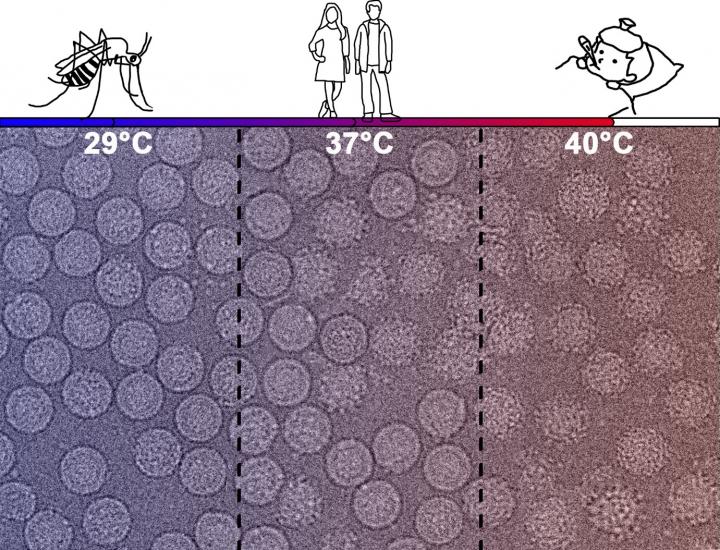
21 Sep Dengue Can Outsmart Vaccines By Mutating When Patient Has Fever
MedicalResearch.com Interview with:
Dr Shee-Mei Lok, PhD
Professor in the Emerging Infectious Disease program
Duke-NUS, a school of National University of Singapore
MedicalResearch.com: What is the background for this study?
Response: Dengue virus consists of four different serotypes (DENV1-4) and within each serotypes, there are multiple strains. In terms of the viral particle shape, our previous research work using some laboratory adapted strains showed these DENV2 strains are very interesting in that it can change shape from the smooth spherical surface particles when grown at mosquito physiological temperature (29oC) and then becomes bumpy surfaced particles when incubated at human physiological temperature (37oC). This ability to transform into different virus surface structures helps the virus to escape from the immune system of the human host. Hence understanding the mechanism of how this occur is important for therapeutics and vaccine development. Here we also identified a laboratory adapted virus strain that do not showed this structural changes.

Micrographs of DENV2 with different distribution of smooth and bumpy surfaced particles when incubated at different temperatures to mimic the physiological temperature in the mosquitoes (29°C, left panel), human host (37°C, middle panel) and when humans are experiencing high fever (40°C, right panel). Colour gradient from blue to red shows the rise in temperature.
Xin-Ni Lim, Emerging Infectious Diseases Programme, Duke-NUS Medical School
We showed some differences in their amino acid sequences and We showed some differences in their amino acid sequences and mutating these residues coupled with observing their surface structures showed which residues are important for this temperature induced structural change. Results showed that subtle mutations at different places on the envelope protein can destabilize the virus allowing them to change in structure when temperature is elevated. Due to the poor selection pressure of the artificial laboratory tissue culture system, gradual mutations of the virus is accumulated causing the virus to have bumpy surface morphology.
MedicalResearch.com: What are the main findings?
Response: We then look at four DENV strains that were obtained from patients (clinical isolate). In contrast to the laboratory adapted viruses, three out of four of these clinical strains maintained smooth surface morphology at 37oC. This shows that the human host selects those with smooth surface morphologies. However, when incubated at 40oC mimicking the fever temperature all virus changes to bumpy surface.
MedicalResearch.com: What should readers take away from your report?
Response: For therapeutic antibody development, some antibodies have been found to be effective for smooth surface virus particles while others, bumpy surfaced. From our current studies, it informs us when to use which kind of antibodies for treatment. For example, for prevention of disease treatment where antibodies are injected to a person before they get infected with dengue, we should use those effective against the smoothed surface virus. When used in patients displaying fever symptoms, we should employ the antibodies effective against the bumpy surface particles.
This study also showed that the lab adapted strain of DENV2 may not be a good model for research as their morphology is different from the clinical strains isolated from patients.
Citation:
Molecular basis of dengue virus serotype 2 morphological switch from 29°C to 37°C
Xin-Ni Lim ,Chao Shan ,Jan K. Marzinek ,Hongping Dong,Thiam Seng Ng,Justin S. G. Ooi,Guntur Fibriansah,Jiaqi Wang,Chandra S. Verma,Peter J. Bond ,Pei-Yong Shi ,Shee-mei Lok
Published: September 19, 2019
[subscribe]
Last Modified: [last-modified]
The information on MedicalResearch.com is provided for educational purposes only, and is in no way intended to diagnose, cure, or treat any medical or other condition. Always seek the advice of your physician or other qualified health and ask your doctor any questions you may have regarding a medical condition. In addition to all other limitations and disclaimers in this agreement, service provider and its third party providers disclaim any liability or loss in connection with the content provided on this website.
Last Updated on September 21, 2019 by Marie Benz MD FAAD
